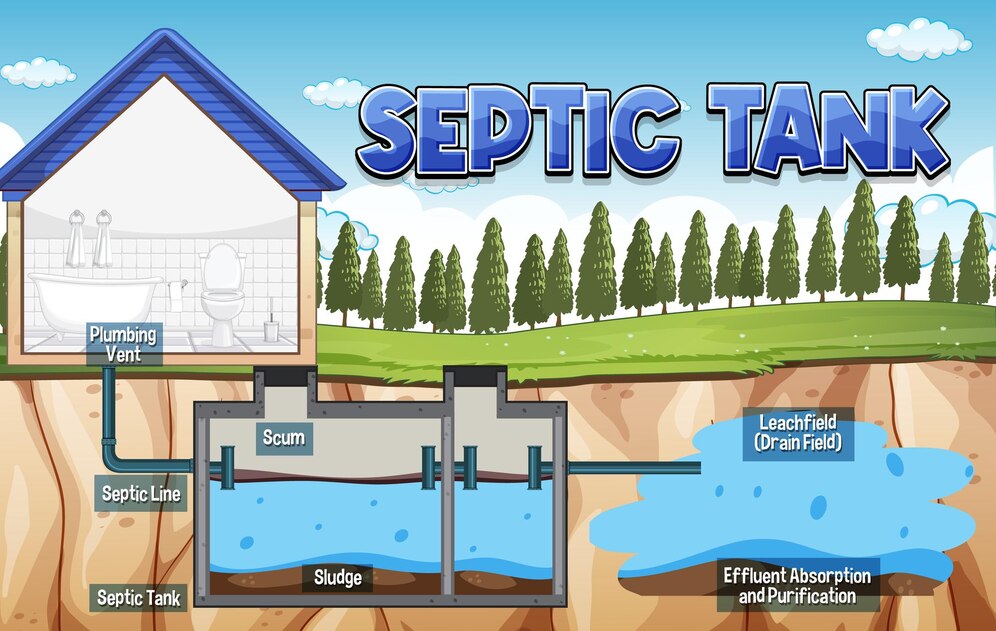Green Alternatives to Septic Systems
For those of us living in rural areas or managing properties away from the convenience of a public sewer, conventional septic systems have long been a go-to solution for waste management. However, as I discovered through my own experience, traditional septic systems aren’t always the most sustainable or effective option. In fact, these systems can often do more harm than good, particularly in environmentally sensitive areas.
In this guide, we’ll explore a range of eco-friendly alternatives to conventional septic systems. From sand filters to constructed wetlands, each option is designed to minimise environmental impact while providing effective, sustainable waste treatment. I’ll share personal stories, expert insights, and practical steps to help you decide which green alternative might be right for your home.
In This Article
- My First Septic System Challenge: Learning the Hard Way
- Exploring Green Alternatives to Septic Systems
- Conclusion
My First Septic System Challenge: Learning the Hard Way
Years ago, when we built our home, we installed a standard septic system. It seemed like a no-brainer. The system worked fine at first, but after a few years, I began noticing some troubling signs. The soil around the leach field became waterlogged, and our well water started showing minor contamination signs. After some research and talking with a few local experts, I learned that the soil in our area was too shallow for a conventional system to function properly. We needed a system that was less invasive and could handle waste in a way that respected the delicate balance of our land.
This experience led me down a path of discovery, learning about alternative septic systems that weren’t just more effective but also better for the environment. Each alternative system I encountered came with unique benefits and challenges, but they all shared one core principle: sustainability.

Exploring Green Alternatives to Septic Systems
Here’s an in-depth look at some of the most popular eco-friendly septic systems available today, along with insights from industry experts and homeowners who have made the switch.
1. Sand Filter Systems
Sand filter systems are an innovative alternative that uses layers of sand to filter wastewater naturally. The system works by directing effluent from the septic tank into a chamber filled with sand, which acts as a natural filter, trapping solids and pathogens. Over time, treated water percolates through the sand and safely re-enters the soil.
I first learned about sand filter systems when a neighbour installed one on their property. They, like us, had soil that was poorly suited to a conventional septic system. After installation, they saw a noticeable improvement in soil quality around their home. What impressed me most was the simplicity of the system – no electricity, no complex machinery, just layers of sand doing the work of cleaning wastewater. Seeing this in action convinced me of the system’s effectiveness, and I now recommend it to anyone facing soil challenges.
According to Dr. Jane Simmons, an environmental engineer specialising in water treatment, sand filters have a unique advantage in that they mimic natural water filtration processes. “Sand has been used for centuries as a natural filter for water treatment,” Dr. Simmons explains. “It’s a low-cost, effective way to treat wastewater without relying on chemicals or energy-intensive processes.” Studies have shown that sand filters can remove up to 95% of pathogens, making them a reliable and eco-friendly option.
Installation and Maintenance Tips
- Placement Matters: Install sand filter systems in areas with well-draining soil for optimal performance.
- Regular Inspection: Check the sand filter annually to ensure there’s no clogging or buildup.
- Cost: Installation can range from $5,000 to $10,000, depending on soil quality and local regulations.
Learn More: Why Are Landfill Sites Bad for the Environment?
2. Aerobic Treatment Units (ATUs)
Aerobic treatment systems are a step up from conventional septic tanks, using oxygen to break down organic material in wastewater more effectively. Unlike anaerobic systems, which rely on anaerobic bacteria, aerobic treatment units introduce oxygen into the tank, promoting the growth of beneficial bacteria that aid in waste breakdown.
After our issues with the conventional system, we decided to switch to an ATU, hoping the higher-efficiency bacteria would help keep our water cleaner. It was an investment, but within weeks of installation, we noticed a reduction in odours around the leach field, and our well water showed a noticeable improvement in clarity and quality. The upfront cost was significant, but the long-term benefits have proven to be well worth it.
Dr. Michael Larson, a professor of environmental science, explains that aerobic systems are particularly useful in areas with poor soil drainage. “ATUs essentially convert organic waste into less harmful byproducts using oxygen, which speeds up the process,” Dr. Larson says. Studies have shown that aerobic systems can produce effluent that’s up to 98% cleaner than that from traditional anaerobic systems, making them a great choice for environmentally sensitive areas.
Installation and Maintenance Tips
- Cost: Installation ranges between $7,000 and $15,000, with annual maintenance adding to long-term costs.
- Power Requirements: Unlike other systems, ATUs require electricity, so ensure a stable power source is available.
- Regular Service: ATUs should be inspected every six months to maintain bacteria levels and system health.
3. Mound Systems
For homes with shallow soil, high groundwater, or bedrock close to the surface, mound systems are an effective alternative. These systems involve constructing a mound of sand and soil above the natural ground level, creating a makeshift leach field. Wastewater is treated as it filters down through the mound.
A close friend of mine opted for a mound system due to high groundwater levels on their property. Initially sceptical about the raised structure, they were pleasantly surprised by how well it blended into the landscape once covered with grass. More importantly, the system has kept their water table safe, even during heavy rains. Their experience has shown me that, despite its appearance, a mound system can be both functional and aesthetic.
According to the EPA, mound systems are an effective solution in areas with poor drainage or high water tables because they allow wastewater to be treated in the mound before it enters the native soil. As Dr. Emily Cooper, an environmental health expert, explains, “The mound system creates a buffer zone, where wastewater is naturally filtered through layers of sand and soil, reducing the risk of groundwater contamination.”
Installation and Maintenance Tips
- Design Considerations: Work with an experienced installer to ensure the mound’s slope and drainage are suited to your land.
- Annual Maintenance: Mound systems require periodic inspections to ensure proper drainage and prevent erosion.
- Cost: Expect to pay between $10,000 and $20,000 for installation, depending on soil conditions and site requirements.
4. Constructed Wetland Systems
Constructed wetlands mimic natural wetlands by using plants to filter and treat wastewater. The system directs wastewater through a constructed wetland area, where plants and microbes work to break down pollutants. This eco-friendly solution provides a unique blend of functionality and aesthetics.
I first saw a constructed wetland system in action during a visit to a nature centre. The system was lush with native plants, and the clean water exiting the system was crystal clear. The staff mentioned that the maintenance mainly involved monitoring plant health and ensuring water flow, which made it both low-maintenance and effective.
Constructed wetland systems are effective because they replicate the filtration processes that occur naturally in wetlands. As Dr. Susan Parker, a wetland ecologist, explains, “Wetlands are nature’s water treatment facilities, using plants and microbes to remove toxins and pathogens from water.” Wetland systems are particularly useful for properties with ample space and adequate sunlight, as plants need light to thrive.
Installation and Maintenance Tips
- Plant Selection: Use native wetland plants adapted to your climate to promote robust growth and filtration.
- Seasonal Maintenance: Check water flow and remove dead plant material to maintain system efficiency.
- Cost: Installation costs vary widely but generally range from $8,000 to $15,000.
5. Drip Distribution Systems
Drip distribution systems offer a unique approach to wastewater treatment by spreading treated effluent evenly over a large area. Unlike conventional leach fields, which rely on gravity, drip distribution systems use small, flexible tubing to deliver wastewater over the surface, promoting even absorption.
A friend recommended a drip distribution system when I was considering alternatives. The low-profile design was appealing, as it’s discreet and doesn’t require mounding or excavation. It’s worked well for them on a sloped property where traditional leach fields wouldn’t work.
Dr. Raymond Hall, a wastewater engineer, explains that drip distribution systems are efficient and reduce soil saturation issues. “These systems distribute effluent at controlled rates, minimising the impact on soil and reducing the risk of contamination,” Dr. Hall notes. By spreading wastewater more evenly, drip systems can extend the lifespan of the leach field.
Installation and Maintenance Tips
- Landscape Integration: Drip systems work well with landscaping, allowing for creative integration.
- Annual Inspection: Ensure tubing isn’t clogged or damaged by roots.
- Cost: Installation costs vary but typically range from $6,000 to $12,000.
Conclusion
Choosing the right septic alternative depends on several factors, from soil quality to budget and personal preferences. Each system has its unique benefits, and with proper maintenance, they can all provide an eco-friendly, sustainable solution to wastewater management. As someone who has navigated the ups and downs of septic system maintenance, I can vouch for the peace of mind that comes from choosing a solution that protects both your home and the environment.
Whether you’re dealing with soil challenges or simply want a more sustainable way to manage wastewater, the options are out there. Take the time to evaluate which system best fits your needs, and remember that investing in a green solution is a step toward a healthier planet and a more resilient property.







